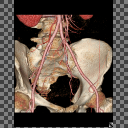The CT-angiogram has shown great utility for DIEP flap, SIEA flap, free TRAM flap, as well as the pedicle TRAM flap in identifying blood supply to the abdominal tissue used in breast reconstruction.

In certain breast reconstruction candidates who have had prior abdominal surgery the CT-angiogram of the abdomen is useful to me not only to plan out the orientation of the flap used in breast reconstruction but also to position the scar on the abdominal wall to facilitate healing.
The illustration below gives an example of a rectus flap planning CT-scan used in breast reconstruction.
Brian P. Dickinson, M.D.
www.drbriandickinson.com
